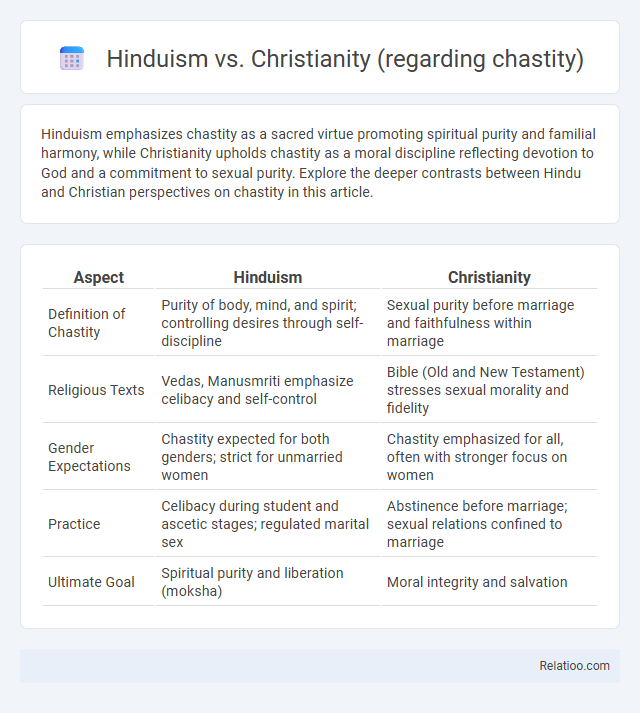Hinduism emphasizes chastity as a sacred virtue promoting spiritual purity and familial harmony, while Christianity upholds chastity as a moral discipline reflecting devotion to God and a commitment to sexual purity. Explore the deeper contrasts between Hindu and Christian perspectives on chastity in this article.
Table of Comparison
| Aspect | Hinduism | Christianity |
|---|---|---|
| Definition of Chastity | Purity of body, mind, and spirit; controlling desires through self-discipline | Sexual purity before marriage and faithfulness within marriage |
| Religious Texts | Vedas, Manusmriti emphasize celibacy and self-control | Bible (Old and New Testament) stresses sexual morality and fidelity |
| Gender Expectations | Chastity expected for both genders; strict for unmarried women | Chastity emphasized for all, often with stronger focus on women |
| Practice | Celibacy during student and ascetic stages; regulated marital sex | Abstinence before marriage; sexual relations confined to marriage |
| Ultimate Goal | Spiritual purity and liberation (moksha) | Moral integrity and salvation |
Introduction: Chastity in Hinduism and Christianity
Chastity in Hinduism is deeply rooted in dharma, emphasizing purity of mind, body, and spirit to maintain cosmic order and personal spiritual growth. Christianity upholds chastity as a virtue reflecting moral integrity and devotion to God, often linked to sexual abstinence outside marriage and faithfulness within it. Your understanding of chastity can be enriched by recognizing these differing religious frameworks that guide ethical behavior and self-discipline.
Defining Chastity: Hindu and Christian Perspectives
Chastity in Hinduism is understood as self-restraint and purity, emphasizing control over desires to attain spiritual progress and maintain dharma. In Christianity, chastity is regarded as a moral virtue involving abstinence from unlawful sexual relations and living a life in accordance with divine commandments. Both traditions highlight chastity as essential for personal holiness and societal harmony, though Hinduism integrates it within broader concepts of karma and moksha, while Christianity links it directly to salvation through adherence to Christ's teachings.
Scriptural Foundations: Sacred Texts on Chastity
Hinduism's sacred texts like the Manusmriti and the Bhagavad Gita emphasize chastity as a vital aspect of dharma, promoting celibacy before marriage and fidelity afterward. Christianity's Biblical foundations, primarily in the New Testament (1 Corinthians 6:18-20 and Hebrews 13:4), underscore chastity as a moral virtue linked to purity and honoring God with your body. Your understanding of chastity can be enriched by exploring how these Scriptures articulate self-control, moral discipline, and spiritual commitment.
The Role of Chastity in Spiritual Life
Chastity in Hinduism is often linked to self-discipline and control of desires, integral to spiritual growth and attaining moksha, with practices like brahmacharya emphasizing celibacy or regulated sexual conduct. Christianity views chastity as a virtue reflecting purity of heart, essential for maintaining holiness and a close relationship with God, often upheld through abstinence outside marriage and fidelity within it. Both religions recognize chastity as a pathway to spiritual cleansing, moral integrity, and deeper devotion, shaping ethical behavior and reinforcing commitment to divine principles.
Chastity in Hindu Practices and Traditions
Chastity in Hinduism is deeply rooted in dharma and purity, often regarded as an essential virtue for spiritual growth and societal harmony. Practices such as brahmacharya emphasize self-restraint and celibacy during student life to cultivate discipline and conserve energy for higher learning and spiritual pursuits. Hindu traditions celebrate chastity not only through vows but also through rituals and teachings in texts like the Manusmriti and Bhagavad Gita, underscoring its role in maintaining moral order and personal sanctity.
Chastity in Christian Doctrine and Life
Chastity in Christian doctrine emphasizes purity of mind and body, often associated with celibacy, especially among clergy and religious orders. It is considered a virtue that aligns with God's commandments, promoting sexual restraint outside the sacrament of marriage to honor divine law. This contrasts with Hindu views, where chastity (Brahmacharya) is a stage of spiritual discipline often linked to celibate living during youth, aimed at self-control and spiritual growth.
Gender and Chastity: Expectations and Differences
Hinduism and Christianity both place significant emphasis on chastity, but their teachings reflect different gender expectations and cultural contexts. In Hinduism, chastity often involves lifelong celibacy for women, especially widows, and self-control for men, aligning with dharma and spiritual purity, whereas Christianity generally promotes chastity before marriage for both genders and fidelity within marriage, emphasizing moral integrity and divine commandments. Your understanding of these differences can highlight how gender roles and societal norms shape the practice and perception of chastity in both religions.
Chastity Before and Within Marriage
Chastity before and within marriage holds significant importance in both Hinduism and Christianity, emphasizing purity and self-restraint as virtues. Hindu teachings advocate for brahmacharya (celibacy or controlled sexual conduct) before marriage and fidelity afterward, aligning with dharma and spiritual growth. Your understanding of chastity in these religions highlights its role in fostering moral discipline, family harmony, and spiritual progress.
Asceticism, Celibacy, and Religious Vows
Hinduism emphasizes chastity through asceticism and celibacy as paths to spiritual liberation, with renunciates (sannyasis) embracing strict vows to transcend material desires. Christianity similarly upholds chastity, especially within monastic traditions, where celibacy and religious vows serve as commitments to divine service and moral purity. Both religions regard these practices as integral to attaining higher spiritual goals, mandating disciplined self-control and dedication to religious duties.
Societal Influence and Modern Interpretations
Hinduism emphasizes chastity as a key virtue linked to purity, dharma, and spiritual progress, traditionally promoting celibacy before marriage and fidelity after, deeply influencing societal norms and family honor. Christianity upholds chastity as a moral mandate, often associated with sexual restraint and purity, shaping cultural expectations around marriage and sexuality through teachings of the Bible and Church doctrines. Modern interpretations in both religions reflect evolving views on individual autonomy and gender equality, blending traditional values with contemporary understandings of consent and personal freedom.

Infographic: Hinduism vs Christianity (regarding chastity)
 relatioo.com
relatioo.com